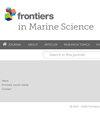温带河口的大型藻类宿主致病性弧菌
IF 3
2区 生物学
Q1 MARINE & FRESHWATER BIOLOGY
引用次数: 0
摘要
人为气候变化正在改变全球沿海系统,影响大型藻类的丰度和组成。这些大型藻类拥有多种微生物群,包括致病菌。特别令人关切的是各种弧菌,如副溶血性弧菌和创伤弧菌,它们与人类疾病有关,并影响沿海地区的公共卫生、经济和娱乐。本研究检测了温带河口(naragansett Bay, RI, USA) 7属大型藻类中致病性弧菌的存在和丰度。利用菌落形成单位(CFU)计数和多重qPCR对副溶血性弧菌和创伤弧菌的丰度进行定量分析,以评估病原菌的丰度是否因大型藻属和形态的不同而不同。我们还研究了影响致病性弧菌流行的潜在环境因素。我们发现创伤弧菌和副溶血性弧菌都存在于所有大型藻属中,其中创伤弧菌的平均丰度更高。温度、盐度和营养物质浓度等环境因素与创伤弧菌或副溶血性弧菌的丰度没有很强的相关性,这表明大型藻类可能为这些病原体提供了保护性的微栖息地。具有机会生存策略的大型藻类中,创伤弧菌和副溶血性弧菌的丰度最高,这表明它们可能是致病性弧菌的宿主,未来的研究应探索更广泛的环境背景和大型藻类与弧菌的相互作用,以更好地了解和预测病原体的动态。本文章由计算机程序翻译,如有差异,请以英文原文为准。
Macroalgae host pathogenic Vibrio spp. in a temperate estuary
Anthropogenic climate change is altering coastal systems globally, affecting macroalgae abundance and composition. These macroalgae host diverse microbiomes, including pathogenic bacteria. Of particular concern are Vibrio species, such as Vibrio parahaemolyticus and Vibrio vulnificus , which are linked to human disease and impact public health, the economy, and recreation in coastal areas. This study examined the presence and abundance of pathogenic Vibrio spp. across seven genera of macroalgae in a temperate estuary (Narragansett Bay, RI, USA). Using colony-forming unit (CFU) counts and multiplex qPCR, we quantified V. parahaemolyticus and V. vulnificus abundance to assess if pathogenic Vibrio abundance varied by macroalgae genus and morphology. We also examined potential environmental factors influencing pathogenic Vibrio prevalence. We demonstrate that both V. vulnificus and V. parahaemolyticus were present on all macroalgae genera, with V. vulnificus showing higher average abundance. Environmental factors like temperature, salinity, and nutrient concentrations did not strongly correlate with V. vulnificus or V. parahaemolyticus abundance, suggesting that macroalgae might offer a protective microhabitat for these pathogens. Macroalgae with opportunistic life strategies had the highest abundance of V. vulnificus and V. parahaemolyticus , highlighting their potential role as reservoirs for pathogenic Vibrio spp. Future research should explore broader environmental contexts and macroalgae–Vibrio spp. interactions to better understand and forecast pathogen dynamics.
求助全文
通过发布文献求助,成功后即可免费获取论文全文。
去求助
来源期刊

Frontiers in Marine Science
Agricultural and Biological Sciences-Aquatic Science
CiteScore
5.10
自引率
16.20%
发文量
2443
审稿时长
14 weeks
期刊介绍:
Frontiers in Marine Science publishes rigorously peer-reviewed research that advances our understanding of all aspects of the environment, biology, ecosystem functioning and human interactions with the oceans. Field Chief Editor Carlos M. Duarte at King Abdullah University of Science and Technology Thuwal is supported by an outstanding Editorial Board of international researchers. This multidisciplinary open-access journal is at the forefront of disseminating and communicating scientific knowledge and impactful discoveries to researchers, academics, policy makers and the public worldwide.
With the human population predicted to reach 9 billion people by 2050, it is clear that traditional land resources will not suffice to meet the demand for food or energy, required to support high-quality livelihoods. As a result, the oceans are emerging as a source of untapped assets, with new innovative industries, such as aquaculture, marine biotechnology, marine energy and deep-sea mining growing rapidly under a new era characterized by rapid growth of a blue, ocean-based economy. The sustainability of the blue economy is closely dependent on our knowledge about how to mitigate the impacts of the multiple pressures on the ocean ecosystem associated with the increased scale and diversification of industry operations in the ocean and global human pressures on the environment. Therefore, Frontiers in Marine Science particularly welcomes the communication of research outcomes addressing ocean-based solutions for the emerging challenges, including improved forecasting and observational capacities, understanding biodiversity and ecosystem problems, locally and globally, effective management strategies to maintain ocean health, and an improved capacity to sustainably derive resources from the oceans.
 求助内容:
求助内容: 应助结果提醒方式:
应助结果提醒方式:


